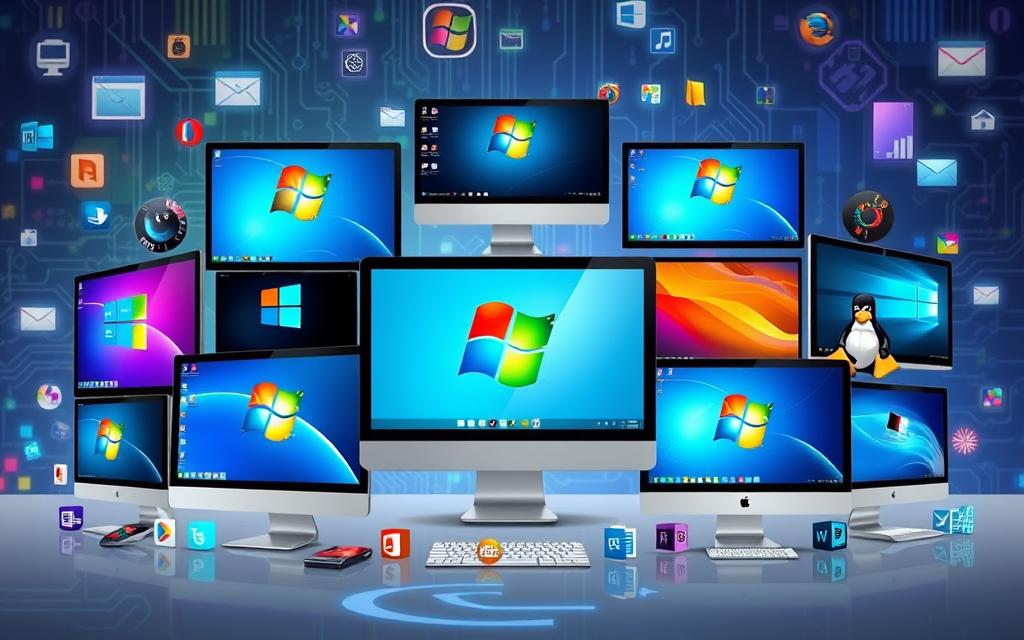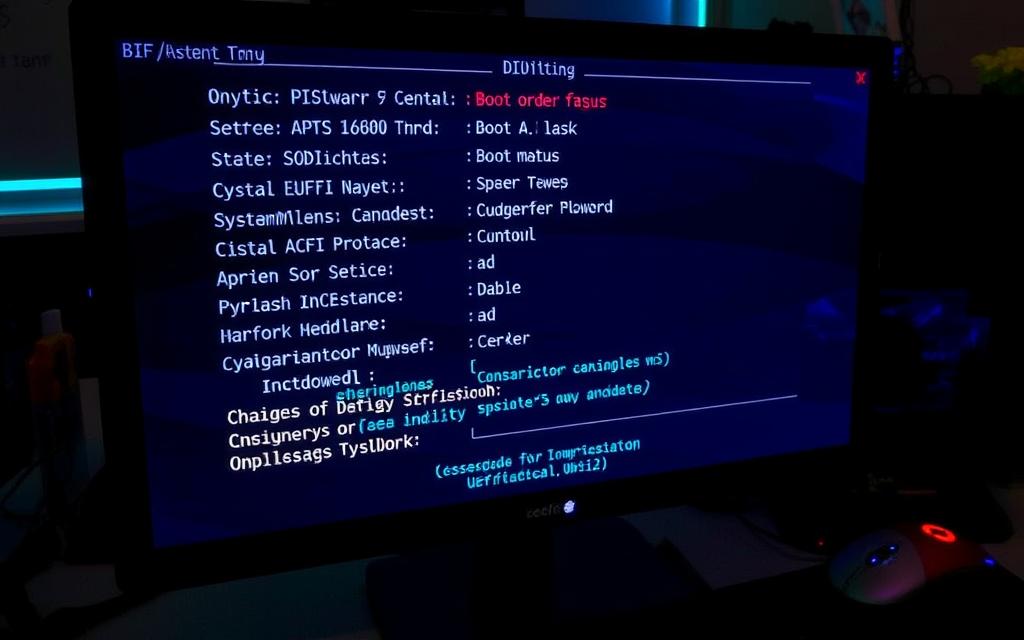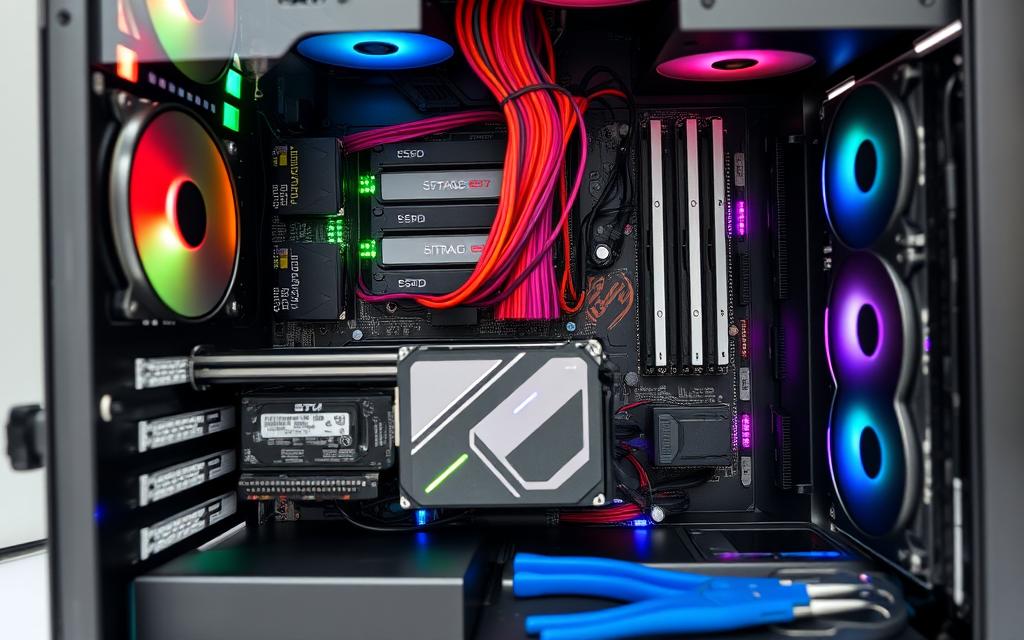Step-by-Step Guide: Installing an Operating System on a New Computer
Installing an operating system on a new computer is key for top performance and security. It makes sure your computer works well with software and hardware. With the right operating system installation guide, you can do this easily. This article will show you how to install an operating system step by step. We’ll cover choosing an operating system, making installation media, and setting up your computer.
Our guide is based on advice from 322 experts. It covers popular choices like Windows 10, Ubuntu Linux, and Mac OS Catalina. By following our guide, you’ll install an operating system on your new computer with confidence. It’s perfect for both new and experienced users, giving you all the tips you need.
Essential Prerequisites for Operating System Installation
Before you install a new operating system, make sure your computer has the right system requirements. You need a compatible processor, enough RAM, and enough storage. Also, you’ll need the right software tools, like a bootable USB drive or installation media.
To find out what hardware components and software tools you need, check the system requirements for your chosen operating system. You can find this info on the manufacturer’s website or in the operating system’s documentation. This ensures your installation goes smoothly.
When looking at system requirements, consider a few important things:
- Processor speed and compatibility
- RAM and storage capacity
- Graphics card and display requirements
- Network and internet connectivity requirements
By carefully checking these factors and making sure your computer meets the system requirements, you can avoid problems. This makes your operating system installation successful.
| Operating System | Minimum Hardware Requirements |
|---|---|
| Windows | 1 GHz processor, 2 GB RAM, 20 GB storage |
| macOS | 2.5 GHz processor, 8 GB RAM, 128 GB storage |
| Linux | 1 GHz processor, 1 GB RAM, 10 GB storage |
Choosing the Right Operating System for Your Needs
There are many operating system options out there, each with its own benefits and drawbacks. To pick the right one, think about compatibility, performance, security, features, and what you like best.
Windows, Linux, and Mac OS are some well-known operating systems. Windows is used by most people, with a wide range of software and hardware support. Linux is loved by developers and tech fans for its flexibility and openness. Mac OS is praised for its easy-to-use design and smooth integration with Apple products.
When picking an operating system, consider these points:
- Compatibility: Make sure the OS works well with your computer’s parts.
- Performance: Look at how fast the OS boots up and runs.
- Security: Choose an OS with strong security, like Linux and Mac OS.

The best operating system for you depends on your needs and likes. Think about compatibility, performance, and security to make a smart choice. This way, you can pick the perfect OS for your computer.
| Operating System | Compatibility | Performance | Security |
|---|---|---|---|
| Windows | Extensive hardware support | Fast boot-up time | Robust security features |
| Linux | Compatible with various hardware components | Customizable performance | Highly secure |
| Mac OS | Seamless integration with Apple ecosystem | Fast performance | Robust security features |
Creating a Bootable Installation Media
To install an operating system on a new computer, you need to create a bootable installation media. This involves USB drive preparation and installation file download. First, prepare your USB drive by formatting it to FAT32. This file system works with both BIOS and UEFI PCs.
The USB drive must have at least 5GB free space for Windows installation. But, using a USB with 8GB or more is better. For more details, visit the official Microsoft website.
After preparing your USB drive, download the Windows installation files. You can get them from the official Microsoft website. Use the media creation tool to make your USB drive bootable.
Here’s how to make a bootable installation media:
- Download the Windows installation files from the official Microsoft website.
- Use the media creation tool to create a bootable installation media.
- Format your USB drive to the FAT32 file system.
- Copy the Windows installation files to your USB drive.
How to Install Operating System on a New Computer
To start, you need to set up the BIOS/UEFI to boot from the installation media. This is key for a smooth install. It lets you arrange the boot order, deciding which device boots first.
Each operating system has its own steps for installation. But, most follow a similar path. You’ll pick your language, region, and settings, and then finish the install. Remember, the boot order is vital for the first boot.
Key Installation Steps
- Configure the BIOS/UEFI settings to boot from the installation media
- Set up the boot sequence to determine the order of booting devices
- Follow the installation process steps to complete the installation
By following these steps and making sure BIOS/UEFI and boot order are right, you can install an OS on a new computer. The steps for each OS might differ, but the main process stays the same.

| Operating System | Installation Method |
|---|---|
| Windows | CD-ROM or DVD installation, network installation (PXE/Jumpstart/RIS) |
| Linux | CD-ROM or DVD installation, network installation (PXE/Jumpstart/RIS) |
It’s also important to note that different operating systems have different installation methods. It’s essential to pick the right method for your specific OS.
Configuring Your Storage Drives
When you set up a new computer, choosing the right storage drive setup is key. This means disk partitioning and file system setup. A good setup makes your system run well and smoothly.
To set up your storage, pick a file system like NTFS or FAT32. Decide on the partition size and number. The file system setup depends on your needs and the OS you’re using.
Here are some important things to think about for storage drive configuration:
- Choose a compatible file system
- Plan your partition scheme carefully
- Consider the size and number of partitions
By planning your disk partitioning and file system setup well, you can make your system fast and compatible. This ensures your new computer works well and efficiently.

Always follow best practices for storage drive configuration to keep your data safe. With a good setup, you’ll have a smooth and efficient computing experience.
| File System | Partition Scheme | Compatibility |
|---|---|---|
| NTFS | Primary and Extended | Windows |
| FAT32 | Primary | Windows and Linux |
Essential Driver Installation and Updates
Installing the right drivers is key for your computer’s hardware to work well. Graphics drivers and network drivers are vital. They let you use your computer’s graphics and connect to the internet. Keeping drivers updated can stop problems like blurry graphics or lost internet.
Microsoft says using Windows Update for patches and drivers keeps your system stable and safe. Using official sources for updates also lowers security risks. Here are some benefits of updating drivers:
- Improved system performance and stability
- Enhanced security features and protection against vulnerabilities
- Optimized hardware performance and compatibility
For instance, updating Nvidia GPU drivers can boost game performance by up to 45%. It’s important to check the compatibility list for your Windows version before installing. This avoids problems from incompatible hardware.
By installing drivers correctly and keeping them updated, your computer will run smoothly. Always use official sources for updates. Also, regularly check for driver updates to keep your system stable and secure.
| Driver Type | Importance | Update Frequency |
|---|---|---|
| Graphics Drivers | High | Regularly |
| Network Drivers | High | Regularly |
| System Updates | High | Automatically |
Personalising Your System Settings
After installing your operating system, personalising your system settings is key. This makes your experience smooth and secure. You’ll need to set up a user account, configure security, and optimise performance.
Setting up a user account is a big part of personalising. You’ll create a unique username and password. You might also need to set up extra user accounts. It’s also important to secure your system with firewall settings, antivirus, and backups.
System Settings Configuration
To tweak your system settings, head to your system’s control panel. Here, you can adjust display, sound, and network settings. You can also set up your security configuration like firewalls and antivirus.
Some key settings to look at include:
- Display settings: adjust screen resolution, brightness, and refresh rate
- Sound settings: tweak speaker, microphone, and sound effects
- Network settings: manage Wi-Fi, Ethernet, and network security
System Optimisation
To get your system running at its best, think about hardware, software, and how you use it. You might upgrade hardware, install new software, or tweak settings for better performance.
| System Component | Optimisation Tips |
|---|---|
| Hardware | Upgrade RAM, get a solid-state drive, and update graphics card |
| Software | Keep software up to date, remove unused programs, and clean the registry |
| Usage Patterns | Close unused programs, use a task manager, and avoid overloading |
By following these tips and adjusting your system settings, you can make your computer secure, efficient, and tailored to your needs.
Troubleshooting Common Installation Issues
Installing a new operating system can sometimes go wrong, leading to frustration. It’s important to find the main problem and fix it. Issues like driver problems, compatibility issues, and error messages need to be addressed.
Understanding error messages is a big part of fixing problems. These messages can tell you what’s wrong and how to fix it. For example, disk problems can often be solved with tools like Auslogics Disk Defrag.
Here are some common problems and how to solve them:
- Driver updates: Use Auslogics Driver Updater to keep drivers current and avoid compatibility issues.
- Activation and product key issues: Check your product key and make sure it’s entered correctly to fix activation problems.
- Windows update and upgrade problems: Fix these by checking for updates and installing the latest ones.
By following these steps and using the right tools, you can fix common installation issues. This will help you install your operating system smoothly. Always back up your data before trying to fix any problems to avoid losing it.
Best Practices for Post-Installation Security
After setting up your operating system, it’s key to focus on security. Antivirus installation is a must to stop malware and viruses. Also, firewall configuration is important to manage network traffic and block unwanted access.
A good firewall stops threats like hacking and data breaches. Keeping your OS updated is also critical. This way, your computer stays safe from threats.
- Installing reputable antivirus software, such as AVG or Norton
- Configuring your firewall to block unauthorized access
- Keeping your operating system and software up to date
- Using strong passwords and enabling two-factor authentication
By following these steps, you can protect your computer well. This ensures your security is strong and effective.
Conclusion: Ensuring Your New Operating System Runs Smoothly
After getting your computer ready for the new operating system installation, the last step is to make sure it works well. Keeping your system updated, improving its performance, and solving problems are essential. This way, your system stays healthy, safe, and works efficiently.
Developers often release updates to keep your system safe from cyber threats. It’s important to keep up with these updates. If you don’t, your system could be at risk. But, by installing updates on time, you keep your system safe.
When you get a new operating system, you might find some bugs. But, with a bit of patience and effort, you can fix these problems. Learning how to solve these issues will help you keep your system running smoothly for a long time.
FAQ
What are the essential prerequisites for operating system installation?
To install an operating system, you need the right hardware and software. You must also check if your computer meets the system requirements. This ensures the operating system works well on your device.
How do I choose the right operating system for my needs?
Think about what you need from an operating system. Consider its compatibility, performance, and security. Also, think about your computer’s hardware and software. This helps choose the best operating system for you.
How do I create a bootable installation media?
To make a bootable installation media, start by preparing a USB drive. Then, download the installation files. Use media creation tools to make the USB drive ready for installing the operating system.
What are the steps to install an operating system on a new computer?
First, set up your BIOS/UEFI settings to use the installation media. Next, set the boot sequence. Follow the installation steps, like choosing your language and settings. Then, complete the installation process.
How do I configure my storage drives for optimal performance and compatibility?
To configure your storage drives, you need to partition the disk and set up the file system. Knowing about different file systems and partitioning schemes is key. This ensures your drives work well with the operating system and other software and hardware.
What essential drivers and updates do I need to install?
You’ll need to install drivers for graphics and networks. Keeping your operating system and drivers updated is also important. This ensures your computer’s hardware works properly and keeps it secure.
How do I personalise my system settings?
Personalising your system involves setting up a user account and security settings. You should also optimise your system for better performance and productivity.
How do I troubleshoot common installation issues?
Troubleshooting issues means fixing error messages and other problems during installation. You might need to adjust BIOS/UEFI settings or reinstall the operating system. Sometimes, you need to address hardware compatibility issues.
What are the best practices for post-installation security?
For security, install antivirus software and configure the firewall. Also, set up backup solutions. These steps help protect your computer from threats and prevent data loss.














